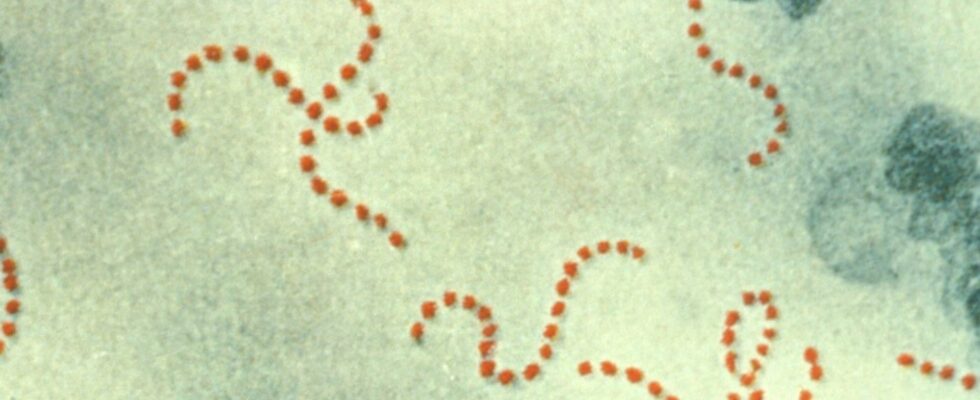The increase in infections linked to a deadly bacteria alarms Japan. The most serious cases, although they have a mortality rate of 30%, remain very rare, and there are already treatments against these infections.
At the end of March 2024, worrying news from Japan made headlines: a deadly bacteria, “ flesh eater “, would be rampant in the country. The number of cases of group A streptococcus infection (or GAS), the name of the bacteria responsible, has reportedly increased significantly since the summer of 2023 in Japan, so much so that several departments in the country have gone into “red alert” . These infections are fatal in one in three cases.
If these kinds of articles take you back to the early days of the Covid-19 pandemic, you’re certainly not alone. However, the two infections are not at all similar: there is already treatment against streptococci, and this is not the first time that an upsurge of the bacteria has hit a country. That’s everything you need to know about GAS, its symptoms, and its treatment.
What is group A streptococcus?
Group A Streptococcus, or Streptococcus pyogenes, is a bacteria responsible for several infections, according to the Pasteur Institute. In the majority of cases, these infections are benign (such as tonsillitis or impetigo), but some can also be very severe, even fatal, such as toxic shock syndrome or necrotizing fasciitis.
It is these last two types of infections that are currently worrying the Japanese authorities. According to Le Monde, “ the National Institute of Contagious Diseases recorded 422 cases between 1er January and March 17. There were 941 in 2023 “, a significant increase in cases, which are usually very unusual. These infections however, still remain very rare compared to the total population.
What are the symptoms ?
Toxic shock syndrome and necrotizing fasciitis are both very serious invasive infections that affect the skin or muscles, and which can quickly lead to “ failure of several organs including acute renal failure, respiratory distress syndrome which is also acute and disseminated intravascular coagulation, a coagulation abnormality which can result in hemorrhages and thromboses », summarizes Le Monde. These infections are as violent as they are rapid, which means that they have high mortality rates, around 30%, according to the Pasteur Institute.
The first symptoms of toxic shock syndrome are a state “ initial flu, which is followed by high fever, tachycardia [rythme cardiaque trop rapide, ndlr]tachypnea [une respiration rapide, ndlr] and intense pain ”, according to the Merck Manual. For necrotizing fasciitis, the symptoms “ begins with fever and exquisite pain [très vive et localisée] out of proportion to clinical signs; pain increases rapidly over time and is often the first (and sometimes only) manifestation », According to the same source.
How is Streptococcus A transmitted?
According to Public Health France, “ GAS is a strictly human pathogen “, that is to say that it is not transmitted from animal to man, or from man to animal. Only humans can transmit it to each other. Streptococcus A is transmitted by respiratory droplets and direct contact (nasal secretions, skin lesions, etc.) “.
However, transmission of the bacteria between two people requires “relatively close contact”, indicates Le Monde. The propagation is therefore “very quickly within a home”, but less in open spaces. Le Monde explains that in France, “ when a case is identified in a class for example, only direct contacts such as play partners or canteen neighbors are considered at risk of being contaminated. »
To protect yourself from infection, it is therefore important to adopt certain barrier gestures. Santé Publique France advises in particular to wash your hands frequently, wear a mask (especially for people with respiratory infections or who are particularly fragile), and sneeze or cough into the crook of your elbow. It is also important to clean and disinfect wounds well.

However, according to the American Centers for Disease Control and Prevention, cited by Le Monde, “for almost half of people with SCTS [syndromes de choc toxique], experts do not know how the bacteria entered the body. Sometimes it enters through openings, such as a wound or surgical wound. It can also enter through the mucous membranes, inside the nose and throat. »
Is there a treatment for Streptococcus A?
Despite a high mortality rate, there are treatments. “ Antibiotics, ß-lactams, currently constitute the standard treatment for streptococcal infections. », specifies the Pasteur Institute. However, there are no vaccines against these infections, but “ several vaccine candidates have been or are being developed “.
Why is there an increase in cases of Streptococcus A?
Several studies attribute this sudden increase in the number of cases to the Covid-19 epidemic. First, the decision in May 2023 to classify Covid as a mild illness led to the relaxation of barrier gestures in Japan. Le Monde also quotes the Minister of Health, Keizo Takemi, who explains that “ one of the factors could be the increase in the number of patients with group A streptococcal pharyngitis since the summer of 2023, in a context of an increase in respiratory infections “.
Another avenue: confinements prevented the creation of a strong immune system against the bacteria. “ It is likely that children have not been exposed to this bacteria as much as usual, so their immune system is probably not as good at fighting it and they could be affected by it. more vulnerable », explains The Conversation. Indeed, “ approximately 10% of school-age children carry this bacteria in the throat and upper respiratory tract, without showing symptoms, and over time develop some immunity against streptococcus A “. An immunity that some children would not have been able to build in recent years.
Japan is not the only country to experience an increase in the number of cases of Streptococcus A. In December 2022, the World Health Organization published a press release to explain that “ Several European countries (including France, Ireland, the Netherlands, the United Kingdom and Sweden) have reported an increase in the number of cases of invasive group A streptococcal disease in children under 10 years of age. » In France, in 2022, there were 59 cases in children, including six deaths.
In the 1980s, “epidemic phenomena were observed,” also notes the National Reference Center for Streptococci. “ These cases of necrotizing dermo-hypodermatitis and streptococcal toxic shock syndrome with rapid and fatal progression confirmed the need for surveillance of GAS infections. » Since then, these infections have indeed been closely followed.
A very different scenario from Covid-19
If recent press headlines may suggest the beginnings of the Covid-19 pandemic, these are two very different diseases and two very different situations. First of all, Covid-19 is an infection caused by a virus, while Streptococcus A is a bacteria. The two diseases are therefore not treated in the same way: as the WHO points out, “ antibiotics do not work against viruses », although they are very effective against bacteria.
Another major difference: Covid-19 was a new disease, for which there was no treatment and about which we knew almost nothing at the start of the pandemic. Streptococcus A has been observed for a long time, and treatment is already available.
Finally, the risk of transmission is not the same. Streptococcus A requires prolonged contact, while Covid was much more easily transmitted. Some variants of the virus were particularly contagious, such as Omicron – which is not the case for Streptococcus A.
If you liked this article, you will like the following: don’t miss them by subscribing to Numerama on Google News.
